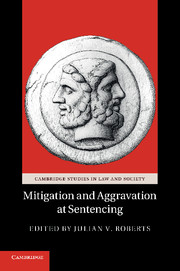Book contents
- Frontmatter
- Contents
- Tables
- Contributors
- Foreword
- Acknowledgments
- Chapter one Punishing, more or less
- Chapter two Re-Evaluating the Justifications for Aggravation and Mitigation at Sentencing
- Chapter three The Search for Principles of Mitigation
- Chapter Four Personal Mitigation and Assumptions about Offending and Desistance
- Chapter Five Intoxication as a sentencing factor
- Chapter Six Beyond the Partial Excuse
- Chapter Seven Equality before the law
- Chapter Eight Personal mitigation
- Chapter Nine Exploring Public Attitudes to Sentencing Factors in England and Wales
- Chapter Ten The Pernicious Impact of Perceived Public Opinion on Sentencing
- Chapter Eleven Addressing Problematic Sentencing Factors in the Development of Guidelines
- Chapter Twelve Proof of Aggravating and Mitigating Facts at Sentencing
- Chapter Thirteen Mitigation in Federal Sentencing in the United States
- Chapter Fourteen The discretionary effect of mitigating and aggravating factors
- Index
- References
Chapter Four - Personal Mitigation and Assumptions about Offending and Desistance
Published online by Cambridge University Press: 07 September 2011
- Frontmatter
- Contents
- Tables
- Contributors
- Foreword
- Acknowledgments
- Chapter one Punishing, more or less
- Chapter two Re-Evaluating the Justifications for Aggravation and Mitigation at Sentencing
- Chapter three The Search for Principles of Mitigation
- Chapter Four Personal Mitigation and Assumptions about Offending and Desistance
- Chapter Five Intoxication as a sentencing factor
- Chapter Six Beyond the Partial Excuse
- Chapter Seven Equality before the law
- Chapter Eight Personal mitigation
- Chapter Nine Exploring Public Attitudes to Sentencing Factors in England and Wales
- Chapter Ten The Pernicious Impact of Perceived Public Opinion on Sentencing
- Chapter Eleven Addressing Problematic Sentencing Factors in the Development of Guidelines
- Chapter Twelve Proof of Aggravating and Mitigating Facts at Sentencing
- Chapter Thirteen Mitigation in Federal Sentencing in the United States
- Chapter Fourteen The discretionary effect of mitigating and aggravating factors
- Index
- References
Summary
When sentencing an offender, sentencers in England and Wales are required to hear any speech in mitigation that the offender or his or her legal representative wishes to make (Shapland 1981). That speech is likely to range widely over all the elements relevant to sentencing for that particular offence and which relate to the legislation governing sentencing. It might include how serious the offence is, whether there are any mitigating or aggravating factors relating to the offence itself and whether the offender should be judged more or less culpable in terms of the part played in the offence. It is also likely to cover personal mitigation, which I shall take as elements relating to the offender and his or her circumstances, history and likely future path. As I shall argue below, little attention has been paid to personal mitigation in official guidance for sentencers. However, for some aims of sentencing – and particularly that of encouraging the offender to commit fewer or no offences in the future (encouraging desistance) – I shall argue that personal mitigation should move from its current obscurity to centre stage.
CHAPTER OVERVIEW
Before turning the spotlight on personal mitigation itself, we need to understand the legislative priorities for sentencers in England and Wales and which of the many possible sentencing philosophies are seen as most important. We then need to look at what guidance is currently given. First, we shall look at how sentencers are currently being provided with any pointers to what to do with personal mitigation. We shall then consider the deficiencies of considering only ‘harm’ and ‘culpability’ in relation to the aims of sentencing and what is known about reducing crime and helping offenders to desist, as well as how to make reparation. The chapter will conclude by considering what sentencing for desistance (offenders leading a less offending or non-offending life) would mean, and how this would affect the importance of personal mitigation.
- Type
- Chapter
- Information
- Mitigation and Aggravation at Sentencing , pp. 60 - 80Publisher: Cambridge University PressPrint publication year: 2011
References
- 3
- Cited by

